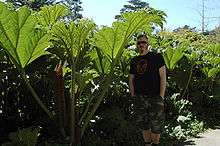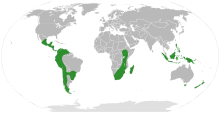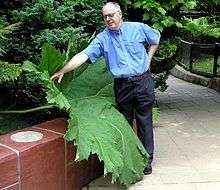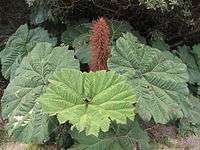Gunnera
Gunnera is the sole genus of herbaceous flowering plants in the family Gunneraceae, which contains 63 species. Some species have extremely large leaves. Species in the genus are variously native to Latin America, Australia, New Zealand, Papuasia, Hawaii, insular Southeast Asia, Africa, and Madagascar.[2] The stalks of many species are edible.
| Gunnera | |
|---|---|
 | |
| Gunnera tinctoria at the San Francisco Botanical Garden at Strybing Arboretum | |
| Scientific classification | |
| Kingdom: | Plantae |
| Clade: | Tracheophytes |
| Clade: | Angiosperms |
| Clade: | Eudicots |
| Order: | Gunnerales |
| Family: | Gunneraceae |
| Genus: | Gunnera L. |
 | |
| The range of the genus Gunnera[1] | |
| Synonyms[2] | |
| |
Description
The 40–50 species vary enormously in leaf size. The giant rhubarb, or Campos des Loges (Gunnera manicata), native to the Serra do Mar mountains of southeastern Brazil, is perhaps the largest species, with reniform or sub-reniform leaves typically 1.5 to 2.0 meters (4.9 to 6.6 ft) long, not including the thick, succulent petiole which may be up to 2.5 meters (8.2 feet) in length. The width of the leaf blade is typically 2.5 meters (8.2 feet), but on two separate occasions cultivated specimens (In Devon, England in 2011[3] and at Narrowwater, Ulster, Ireland[4] in 1903) produced leaves fully 3.3 meters (11 feet) in width, not far from the largest of all dicot leaves such as Victoria amazonica. The seeds germinate best in very moist, but not wet, conditions and temperatures of 22–29 °C.
Only slightly smaller is G. masafuerae of the Juan Fernandez Islands off the Chilean coast. They can have leaves up to 2.9 m (9 ft 6 in) in width on stout leaf stalks 1.5 m (4.9 ft) long and 11 cm (4.3 in) thick according to Skottsberg.[5] these leafstalks or petioles are the thickest of any dicot, and probably also the most massive. On nearby Isla Más Afuera, G. peltata frequently has an upright trunk to 5.5 m (18 ft) in height by 25–30 cm (9.8–11.8 in) thick, bearing leaves up to 2 m (6 ft 7 in) wide. The Hoja de Pantano (G. magnifica) of the Colombian Andes bears the largest leaf buds of any plant; up to 60 cm (2.0 ft) long and 40 cm (16 in) thick.[6] The succulent leaf stalks are up to 2.7 m (8 ft 10 in) long. The massive inflorescence of small, reddish flowers is up to 2.3 m (7 ft 7 in) long and weighs about 13 kg. Other giant Gunnera species are found throughout the Neotropics and Hawaii. Gunnera insignis is also known by the name "poor man's umbrella" in Costa Rica.
Several small species are found in New Zealand, notably G. albocarpa, with leaves only 1–2 cm long, and also in South America, with G. magellanica having leaves 5–9 cm wide on stalks 8–15 cm long.


Taxonomy
The genus Gunnera was named after the Norwegian botanist Johann Ernst Gunnerus. At first it was assigned to the family Haloragaceae, though that presented difficulties that led to the general recognition of the family Gunneraceae, as had been proposed about the beginning of the 20th century. In the meantime in many publications it had been referred to as being in the Haloragaceae, variously misspelt (as for example "Halorrhagidaceae".[7]) Such references still cause difficulties in consulting earlier works. However, currently Gunnera is firmly assigned to the monogeneric family Gunneraceae.[8]
- Species[2]
- Gunnera aequatoriensis - Ecuador
- Gunnera albocarpa - New Zealand
- Gunnera annae - Peru, Bolivia
- Gunnera antioquensis L.E.Mora - Colombia
- Gunnera apiculata - Bolivia, Argentina
- Gunnera arenaria - New Zealand
- Gunnera atropurpurea - Colombia, Ecuador
- Gunnera berteroi - Bolivia, Argentina, Chile
- Gunnera bogotana - Colombia
- Gunnera bolivari - Peru, Ecuador
- Gunnera bracteata - Robinson Crusoe Island in Chile
- Gunnera brephogea - Colombia, Ecuador, Peru
- Gunnera caucana - Colombia
- Gunnera colombiana - Colombia, Ecuador
- Gunnera cordifolia - Tasmania
- Gunnera cuatrecasasii - Colombia
- Gunnera densiflora - New Zealand
- Gunnera dentata - New Zealand
- Gunnera diazii - Colombia
- Gunnera flavida - New Zealand
- Gunnera garciae-barrigae - Colombia
- Gunnera hamiltonii - New Zealand
- Gunnera hernandezii - Colombia
- Gunnera herteri Osten - Uruguay, S Brazil
- Gunnera insignis - Panama, Nicaragua, Costa Rica
- Gunnera kauaiensis - Kauai in Hawaii
- Gunnera killipiana - Chiapas, Guatemala, Honduras
- Gunnera lobata - Tierra del Fuego
- Gunnera lozanoi - Colombia
- Gunnera macrophylla - Papuasia, Indonesia, Philippines
- Gunnera magellanica - W + S South America, Falkland Is.
- Gunnera magnifica - Colombia
- Gunnera manicata - S Brazil
- Gunnera margaretae - Peru, Bolivia
- Gunnera masafuerae - Alejandro Selkirk Island (Isla Mas Afuera) in Chile
- Gunnera mexicana - Veracruz, Chiapas
- Gunnera mixta - New Zealand
- Gunnera monoica - New Zealand incl Chatham Islands
- Gunnera morae - Colombia
- Gunnera peltata - Robinson Crusoe Island in Chile
- Gunnera perpensa - Africa, Madagascar
- Gunnera peruviana - Ecuador, Peru
- Gunnera petaloidea - Hawaii
- Gunnera pilosa - Peru, Bolivia, Ecuador
- Gunnera pittieriana - Venezuela
- Gunnera prorepens- New Zealand
- Gunnera quitoensis - Ecuador
- Gunnera reniformis - New Guinea
- Gunnera saint-johnii - Colombia
- Gunnera sanctae-marthae - Colombia
- Gunnera schindleri - Bolivia, Argentina
- Gunnera schultesii - Colombia
- Gunnera silvioana - Ecuador, Colombia
- Gunnera steyermarkii - Venezuela
- Gunnera strigosa- New Zealand
- Gunnera tacueyana - Colombia
- Gunnera tajumbina - Ecuador, Colombia
- Gunnera talamancana - Costa Rica, Panama
- Gunnera tamanensis - Colombia
- Gunnera tayrona - Colombia
- Gunnera tinctoria - Chile, Argentina
- Gunnera venezolana - Venezuela
Cyanobacterial symbiosis
At least some species of Gunnera host endosymbiotic cyanobacteria such as Nostoc punctiforme The cyanobacteria provide fixed nitrogen to the plant, while the plant provides fixed carbon to the microbe.[9] The bacteria enter the plant via glands found at the base of each leaf stalk[1] and initiate an intracellular symbiosis which is thought to provide the plant with fixed nitrogen in return for fixed carbon for the bacterium. This intracellular interaction is unique in flowering plants and may provide insights to allow the creation of novel symbioses between crop plants and cyanobacteria, allowing growth in areas lacking fixed nitrogen in the soil.
Uses
The stalks of G. tinctoria (nalcas), from Southern Chile and Argentina, are edible. Their principal use is fresh consumption, but also they are prepared in salads, liquor or marmalade. Leaves of this species are used in covering curanto (a traditional Chilean food).
Gunnera perpensa is a source of traditional medicine in Southern Africa, both in veterinary and human ailments, largely in obstetric and digestive complaints, but also as a wound dressing.[7] It also is eaten in various ways, largely the petioles, flower stalks and leaves, fresh and raw, preferably with skins and fibre removed, which is said to remove bitterness, but also cooked. The plant also is said to be used in making a beer.[10]
References
- Bergman, B.; Johansson, C.; Söderbäck, E. (1992). "The Nostoc–Gunnera symbiosis". New Phytologist. 122 (3): 379. doi:10.1111/j.1469-8137.1992.tb00067.x.
- Kew World Checklist of Selected Plant Families
- "Abbotsbury Gardens celebrates plant's 'monster' leaves". BBC. 14 October 2011.
- The Garden (London) Vol. 63 # 1631 (February 21, 1903) p. 125.
- Dr Carl Skottsberg, , "The Phanerogams of Juan Fernandez Islands", NATURAL HISTORY OF JUAN FERNANDEZ AND EASTER ISLAND (Uppsala: Almqvist & Wiksells Buktrykeri A.S., 1953) Vol. 2 p.151.
- Dr. Harold St. John, "Gunnera the Magnificent - Giant Herb of Colombia", CHICAGO NATURAL HISTORY MUSEUM BULLETIN, Vol. 30 # 1 (January 1959) p. 3 plus photo on front cover.
- Watt, John Mitchell; Breyer-Brandwijk, Maria Gerdina: The Medicinal and Poisonous Plants of Southern and Eastern Africa 2nd ed Pub. E & S Livingstone 1962 (Described in chapter on Halorrhagidaceae, p 500)
- Wanntorp, L. Wanntorp, H-E. Oxelman, B. Källersjö, M. Phylogeny of Gunnera. Plant Systematics and Evolution Vol. 226, No. 1/2 (March 2001), pp. 85-107
- Francis C. Y. Wong and John C. Meek. Establishment of a functional symbiosis between the cyanobacterium Nostoc punctiforme and the bryophyte Anthoceros punctatus requires genes involved in nitrogen control and initiation of heterocyst differentiation. Microbiology (2002), 148, 315-323 [www.microbiologyresearch.org]
- Fox, Francis William. Food from the veld. Pub: Delta Books (1982) ISBN 978-0908387328
External links
- The Gunnera Gallery
- Gunnera magellanica pictures from Chilebosque
- Global Invasive Species database Gunnera tinctoria
- Medicinal plant details Gunnera perpensa
- Gunnera on Achill Island